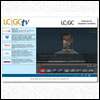| To kick-start 2015 the LCGC editorial team has compiled the 14 biggest stories of the last year. From the launch of LCGC TV to a review of superficially porous particles, from injecting in the mobile phase to the future of miniature mass spectrometers — these popular pieces stand for their technical know-how, unique insight, and perspective. |
|
|
 |
1. LCGC TV Library
The top highlight of 2014 as chosen by the LCGC Editorial team was the launch of the new LCGC TV platform. Featuring interviews with industry leaders, the library was (and continues to be) updated with a different subject focus every month. |
|
| Looking to Eliminate Problems associated with Sample Preparation? |
Although automating analytical techniques has become status quo, sample preparation is still considered to be the bottleneck of the laboratories processes. Learn how automation can reduce labor and time, increase recoveries and produce consistent, reproducible results. If this and cutting sample preparation costs is important to your laboratory review the new  From Sample to Vial Automated Sample Prep Solutions notebook. From Sample to Vial Automated Sample Prep Solutions notebook. |
|
|
|
|
|
|
| New Agilent AdvanceBio RP-mAb |
The only reversed-phase columns focused on the unique challenges of mAb characterization. Superficially porous particles (3.5 μm) with wide pores (450Å) increase mAb resolution, providing shorter analysis times than fully porous particles. The robust Poroshell packed bed and 2 μm inlet frit extends column lifetime by preventing inlet blockage. A range of chemistries is available for flexible method development.  Learn More Learn More |
|
|
|
Medicines.JPG)
Photo Credit: Ethan Myerson/Getty Images | 6. Current Practices and Considerations for a Stability-Indicating Method in Pharmaceutical Analysis
The demonstration of drug substance (DS) or drug product (DP) stability over the shelf life is a regulatory requirement in the pharmaceutical industry. To fulfill this requirement, a stability-indicating method (SIM) must be developed and validated to separate and quantify both the active pharmaceutical ingredient (API) and its related compounds. This article discussed the characteristics and relevant considerations for the development and validation of a SIM. |
|
|
|
| LCGC E-Book: Controlling Selectivity in Reversed-Phase LC |
Reversed-phase liquid chromatography (LC) is the most common mode of liquid chromatography, and a powerful analytical tool. Getting the most from it, however, requires achieving the selectivity needed for your specific separation. In this e-book, John Dolan, renowned LC expert and the longtime author of the "LC Troubleshooting" column in LCGC presents four steps to controlling selectivity in reversed-phase LC.  Download Today Download Today |
|
|
|
|
|
|
|
|
|
|
|
Drugs.JPG)
Photo credit: Jorg Greuel/Getty Images | 13. Impact of New Columns on Drug Development
This article examined the development of new types of columns based on different particle types, sizes, and other physical characteristics and how they can improve the speed and efficiency of HPLC used to support more expansive and complicated analyses. |
|
CTMS.JPG)
| 14. Current Trends in Mass Spectrometry: A Convenient Alternative to MALDI and ESI
Ionization of small, large, volatile, and nonvolatile compounds with charge states nearly identical to electrospray ionization are produced from a solid matrix or solution with high sensitivity utilizing the vacuum inherent with any mass spectrometer. With the proper matrix, analytes can be analyzed from ambient conditions or by direct introduction into vacuum. |
|